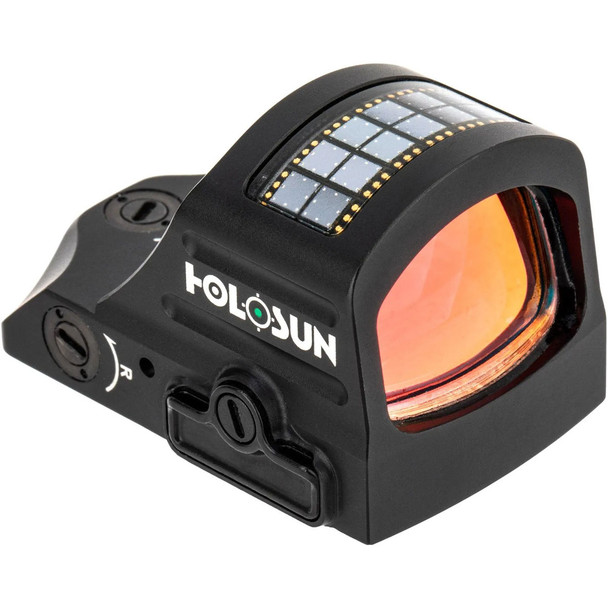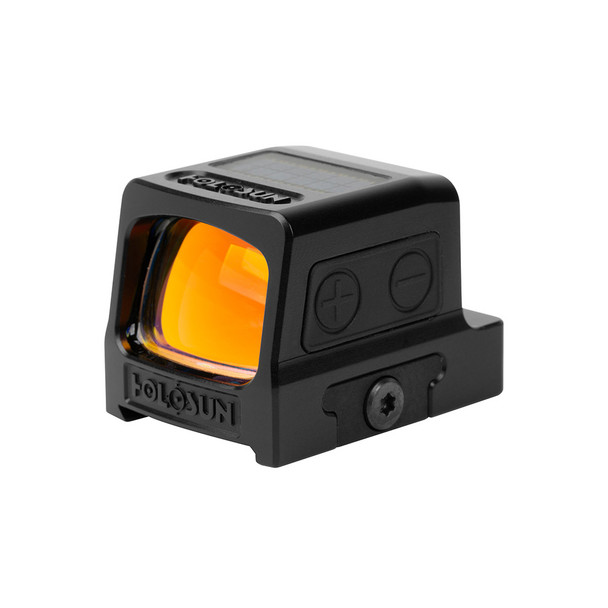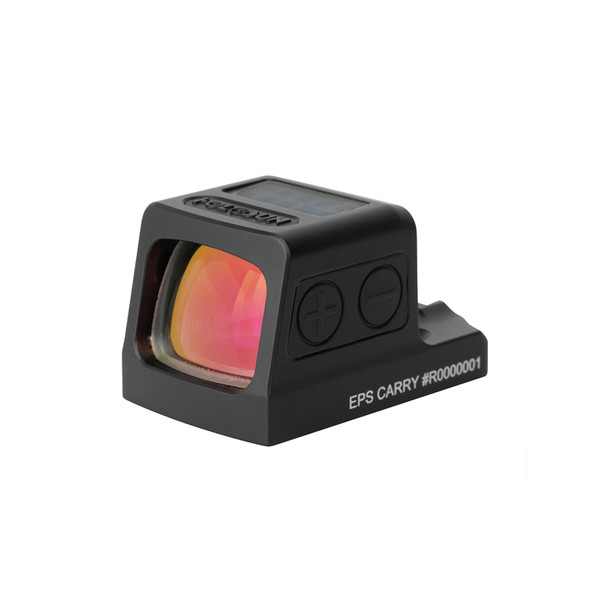
A lot of folks with astigmatism assume that the starbursts they see through their red dot optic are just a fact of life and there’s nothing they can do about it. That’s not true. Did you know that the same red dot can look completely different to two people with astigmatism? So if you’re seeing major distortions, it may be the case that this particular optic just isn’t right for your eyes. There’s likely a red dot out there that works better for you—you just haven’t found it yet. To help you get started, we’ve put together this guide to astigmatism red dot sights.

Everyone’s Astigmatism Is Different
Astigmatism changes how your eyes focus light, which can cause red dot sights to appear distorted—like starbursts, smudges, or streaks. The thing is it’s not the same for everyone. One person might see a dot as an oval, while another sees a comet-like streak shooting in different directions. Since astigmatism varies so much from person to person, finding the right optic is about matching it to your specific type of astigmatism.
So what works for someone else might not work for you. Recommendations are a great starting point but it would be best if you go to your local gun store / shooting range and ask a couple of sight models to see through with your eyes.
Lens Glass Matters
Experienced shooters with astigmatism often find that sights with real glass lenses create less distortion than those using polycarbonate or plexiglass.
Holosun sights are known for their high-quality glass, which allows for better light transmission and minimizes distortion. A good example is the Holosun 509T, which not only boasts high glass quality but also tends to be generally better for astigmatism due to the enclosed emitter design that reduces glare and protects the glass from lint and debris.
 Taken from r/ar15
Taken from r/ar15
Don’t Over-adjust Brightness
New red dot users often crank up the brightness too high, which can make the dot appear worse. When the dot is too bright, the light refracts unevenly in your eye, making distortions more noticeable. So turning the brightness down can often help reduce this effect.
Optics with auto-brightness adjustment, like the Holosun 407C or 507C, are great for adapting to changing lighting conditions without constant tweaking. If the optic you’re considering doesn’t have this feature, try experimenting with lower brightness settings in-store.

Should You Always Go Green?
While many people swear by green dots for astigmatism, don’t blindly follow this advice. It’s true that green dots are often easier to see and can cause less distortion for some, but astigmatism varies greatly from person to person. In fact, some individuals actually see red more clearly than green.
Here’s a quick experiment: stand at a traffic light at night and observe which color appears cleaner to you.
Also, while rarer, some sights offer gold reticles, which some users also find easier on the eyes.
2MOA vs. 6MOA?
Dot size plays a big role in adjusting for astigmatism. If the dot you’re seeing looks like a fuzzy supernova, switching to a larger dot, a 6 MOA, for instance, might help. You can keep it at a lower brightness and look through it, focusing on the target rather than the dot.
Conversely, smaller dots—like 2 or 3 MOA—can appear sharper since their smaller size reduces the area where distortion can settle.
Another great option is a circle-dot reticle, like the one found in the Holosun red dots with Multi-Reticle System (MRS). These reticles offer multiple reference points, helping your eyes focus within the circle.

Enclosed or Open Emitters?
The choice of sight housing often comes down to personal preference. Still, for shooters with astigmatism, enclosed emitters like the Holosun EPS, 509T, or SCS Carry might work a bit better since enclosed emitters reduce glare or reflections and protect against dust, debris, or lint that can cause additional visual distortions.
Best Holosun Red Dots for Astigmatism (for pistol shooters)

Holosun EPS Carry Green MRS
$429.99
Price accurate at time of writing
Why good for astigmatism:
- MRS: 2 MOA Dot & 32 MOA Circle
- Green reticle (often provides better clarity than red)
- Enclosed emitter design reduces environmental interference (e.g., debris, glare)
- Available with 2MOA dot, 6MOA dot, or MRS.
Specs:
- Features: Solar Failsafe, Shake Awake Technology with Last Setting Recall
- Housing: 7075 T6 Aluminum Housing
- Lens: Aspherical Glass Lens with Zero Distortion
- Brightness settings: 10 DL & 2 NV
- Weight: 1oz
- Window size: 0.58x0.77
- Fits: Subcompact pistols for CC

Holosun 507C X2 Green ACSS Vulcan
$359.99
Price accurate at time of writing
Why good for astigmatism:
- Multiple reticle system: ACSS Vulcan reticle (10 MOA center chevron) + Large outer reference circle
- Green reticle (often provides better clarity than red)
Specs:
- Features: Solar Failsafe, Shake Awake Technology
- Housing: 7075 T6 Aluminum Housing
- Lens: Fully multicoated glass
- Brightness settings: 12
- Weight: 1.5oz
- Window size: 23 x 17 mm
- Fits: Full size & compact pistols

Holosun 509T X2 Green MRS
$459.99
Price accurate at time of writing
Why good for astigmatism:
- MRS: 2 MOA Dot & 32 MOA Circle
- Green reticle (often provides better clarity than red)
- Enclosed emitter design reduces environmental interference (e.g., debris, glare)
Specs:
- Features: Solar Failsafe, Shake Awake Technology
- Housing: Titanium Housing
- Lens: Fully multicoated glass
- Brightness settings: 10 DL & 2 NV
- Weight: 1.72oz
- Window size: 0.66 x 0.9
- Fits: Full size & compact pistols
If Holosun Doesn’t Work for Your Astigmatism
If none of the Holosun options seem to fit, here are alternative optics you can consider:
Pistol users:
While Holosun sights are great for astigmatism, with their high-quality glass lens, super crisp reticles, and the MRS tech, there’s still a possibility Holosun won’t work for your specific type of astigmatism. If that’s the case, it’s worth exploring other brands since they might use glass coatings, lenses, or reticle styles (like a 64 MOA circle instead of 32 MOA) that might work better for your eyes.
Rifle users:
Prism optics are a good choice for people with astigmatism thanks to their etched reticles. Unlike red dots that rely on LED emitters, prism reticles don’t depend on illumination and stay sharp and clear no matter your eye condition. Plus, with diopter adjustments, prism sights allow you to fine-tune the focus to work around the natural distortions caused by astigmatism.
Why prisms work for astigmatism:
- Sharp, etched reticles are always visible—even without illumination.
- Adjustable focus helps compensate for individual vision needs.
- Available in various magnifications.
Pay attention prism scopes have shorter eye relief.
Holographic sights, like EOTech, are also great for shooters with astigmatism due to the nature of the holographic technology. Unlike traditional red dots that project an LED through a single lens, EOTech sights use a laser-based hologram etched into the viewing window. This design creates a crisp, clean reticle that’s far less prone to the starburst effect.
Why holographic sights work for astigmatism:
- The reticle appears to sit “inside” the target plane, reducing distortion.
- Holographic laser tech delivers clarity across different brightness levels.
- The slightly grainy texture of holographic reticles feels more natural, helping you focus on the target instead of the reticle.
Tips for Mastering Red Dots with Astigmatism
Even with the right optic, there are additional steps you can take to improve clarity and accuracy:
Shooting Technique: Practice focusing on the distant target rather than the dot itself. This trick can reduce perceived blur.
Test Before Buying: Astigmatism varies greatly between individuals. Visit a gun store and look through as many optics as possible to find the best fit for your eyes.
- Prescription Glasses or RGP Contacts: Corrective lenses designed for astigmatism can drastically enhance your visual experience when using optics.









Leave a Reply